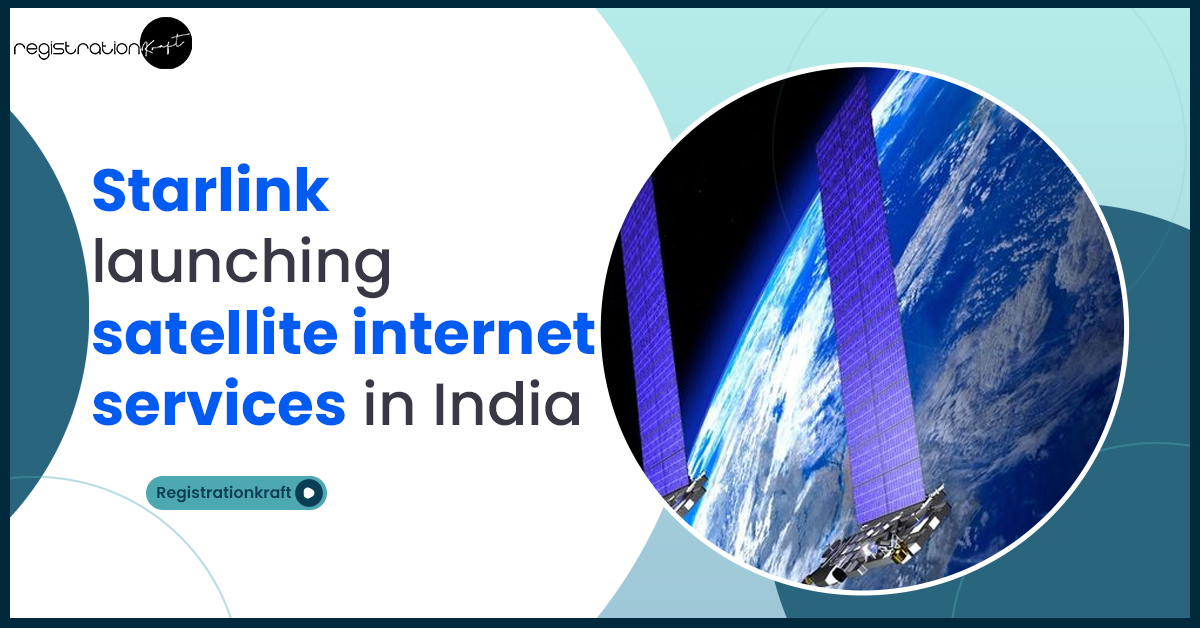Have you ever seen a string of lights in the sky during night? If yes, you might be curious about it. It is quite obvious and you should know that it is Starlink satellite. Starlink has over 4K+ satellite orbiting the earth over us and this number of just more than half of the total no. of active satellites present in the orbit. But it is not just enough of it as it may refer to several other things. For example, Starlink has recently announced that it is going to provide its satellite internet services to users in India. The technology firm has completed all the processes with the respective government body and is all set to obtain a license after getting over with the underlying regulatory guidelines.
According to the credible sources, Starlink is expected to get the license from the Government of India by end of January after clearing out the shareholding pattern to the Department for Promotion of Industry and Internal Trade. Once this is done, the Department of Telecommunications (DoT) would provide the concerned letter of intent to Starlink.
The department is currently on its way to prepare a note that will be forwarded to telecom secretary Neeraj Mittal and minister of communications Ashwani Vaishnav for their endorsement. After receiving their nods, the department’s Satellite Communications Wing will grant the approval to Starlink.
Starlink made an application to secure a global mobile personal communication by satellite services (GMPCS) licence in 2022. Due to which, it would become the third company – after Jio Satellite Communications and OneWeb – to procure this licence.
What is Starlink?
Starlink refers to a constellation of satellites that are meant to provide internet coverage globally. This system has been primarily designed for rural and geologically distant areas where it is difficult to provide internet connectivity.
Starlink is an initiative by SpaceX initiative to set the ground for a global broadband network through constellation of small satellite present at the lower orbit of the earth. The main objective of this endeavor is to provide high-speed internet services to users. SpaceX is officially known as Space Exploration Technologies Corp. It is a private firm specializing in rocket technology and was founded by Elon Musk in 2002.
How does Starlink work?
Starlink system is based on on a satellite-linked internet service technology that has been in use for several decades. Rather than relying on typical cable-based technology, such as fiber optics to broadcast internet data, Starlink uses a satellite system that sends radio signals through the vacuum of space. The earth-based stations transmit signals to satellites hovering in orbits, which then sent back the data to the users on Earth. Each satellite in the Starlink constellation has a weight of around 573 pounds with a flat body. One SpaceX Falcon 9 rocket can carry to 60 satellites in the orbit.
What does Starlink aim for?
The first and foremost objective of Starlink is to establish a low latency network in space that can enable edge computing on the plant. The biggest challenge of establishing a global network in outer space is not just one, particularly as low latency is a crucial element. SpaceX has planned a group of nearly 42,000 tablet-size satellites encircling the earth in low orbit to make this happen. The CubeSats — miniature satellites are widely used in LEO given smarter network coverage, and their low Earth orbit results in low latency.
Other players in the similar category are HughesNet, OneWeb, Amazon, and Viasat. Below are the things that make Starlink different from its counterparts.
- Rather than employing some large satellites, Starlink leverage the power of several small satellites.
- Starlink makes the use of LEO satellites that hover over Earth at just 300 miles above surface. This reduced geostationary orbit results in improved internet speeds and low latency levels.
- The latest Starlink satellites are based on laser communication points when it comes to transmitting signals among satellites, thereby bringing down dependency on various ground stations.
- SpaceX has plans to project as many as 40,000 satellites in coming months with an aim to ensure global and remote satellite exposure with much lesser service breaks.
Internet Speed of Starlink
According to a study done by Ookla, Starlink attained its best median download speed in the first quarter of 2022 at 160 Mbps in Lithuania. Starlink also recorded a speed of 91 Mbps in the United States of America, 97 Mbps in Canada and 124 Mbps in Australia. Mexican Starlink is known to be the best satellite internet in North America, with a whopping median download speed of 105.91 Mbps. The study also shown that upload speeds have witnessed a downhill curvature of minimum 33% in the U.S. — from 16.29 Mbps in the first quarter of 2021 to 9.33 Mbps in the second quarter of 2022.
Starlink in India
Starlink encountered a few issues in 2021 with the government of India for longsuffering pre-orders for its terminals at a reasonable cost. Though Starlink planned to do trials for its satellite communication services in India, there was no positive response as the government asked Starlink to refund the deposited amount that was collected without seeking prior permissions for operations.
This was followed by the resignation of Sanjay Bhargav, who was the head of Starlink’s India division.
In 2022, Starlink also applied to the DoT to perform some trials with several user terminals and gateway stations with an aim to embrace technology and capability demo, product steadiness, and ecosystem expansion. But, those trials were not permitted.
How Starlink’s services will benefit the users in India?
Satellite communication, or sitcom is meant to enable broadband speeds that can be compared to 4G network. This speed can go up to 100 megabits per second (Mbps). However, it can attain the level of up to 10 gigabits per second (Gbps), equivalent to 5G speed.
Starlink users usually get data download speeds of up to 220 Mbps, with most users get speeds of over 100 Mbps. Upload speeds stand generally between 5 and 20 Mbps. This technology is great to users living in distant areas that are inaccessible through conventional cable-based traditional internet infrastructure.
Quick and easy installation and application of satellite communication is one of the major benefits of Starlink. The company has also made a point that satellite broadband connections are exceptionally beneficial for educational institutes and healthcare facilities operating in remote areas of the country. The company may first think about offering internet services straight to customers and then the corporate sector.

